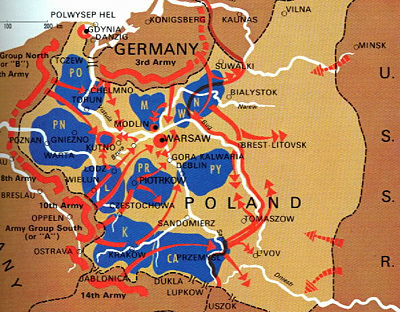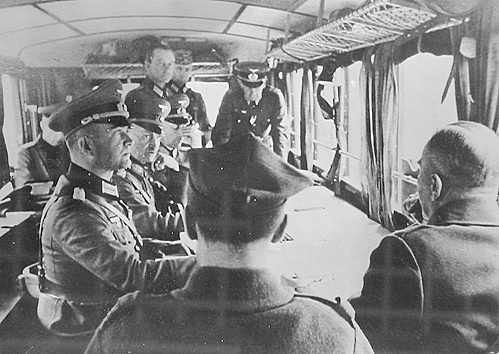
The attacks into Poland was to be carried out by two powerful German Army Groups: Army Group North, under Colonel-General Fedor von Bock, and Army Group South, under Colonel-General Gerd von Rundstedt.
Map from History of World War 2, p.40
Army Group North
AGN consisted of two Armies.
On the left flank, attacking from East Prussia was the 3rd Army, under General Georg von Kuchler, with eight infantry divisions, was to assist in the destruction of the Polish forces in the Corridor and rapidly drive south towards the Vistula and Warsaw. On the right flank was the 4th Army, under General Gunther Hans von Kluge, with six infantry divisions, two motorised divisions, and one Panzer division, was to attack from Pomerania and destroy the bulk of Polish troops defending the Corridor, cutting off the Poznan-Kutno group from the north.
Army Group South
AGS consisted of three Armies.
The 8th Army, on the left under General Johannes Blaskowitz, with four infantry divisions and the SS. motorised regiment Leibstandarte Adolf Hitler, was to engage the Polish forces in the Poznan-Kutno region and keep them from counter-attacking the central army of Army Group South.
In the centre was the 10th Army, under General Walter von Reichenau, with six infantry divisions, two motorised divisions, two Panzer divisions and three light divisions, was to drive north-east, straight for Wielun, Lodz, and Warsaw.
On the right flank, was the 14th Army, under General Sigmund Wilhelm List, with two Panzer divisions, one light division, one mountain division, six infantry divisions and the SS. motorised regiment Germania, was to strike across the Carpathians from Slovakia and pin down the Polish forces around Krakow and Przemysl.
The Polish border with Germany was 1,250 miles long and recently been extended to 1,750 miles by the German occupation of Czecho-Slovakia. Now both northern and southern Polish flanks were exposed to invasion.
Marshal Edward Smigly-Rydz, the Polish Commander-in-Chief, had decided to spread the bulk of his armies along the 1750 mile frontier with Germany. He positioned weak reserves in front of Warsaw. The Polish army had about as many infantry as the Germans, but they spread all along the frontier and were in no condition to fight concentrated German mobile attacks.
Once the German army had penetrated the thin Polish lines, there were not enough Polish reserves behind the front to counter-attack. The only strong defensive line was to dig behind the Vistula, and San rivers, but this would had meant conceding from the outset of war, the richest indutrial and agricultural regions of Poland.
By 3rd September, 1939, the German 4th Army (Kluge) had rapidly advanced and cut the Corridor and reached the Lower Vistula, while the 3rd Army (Kuchler), was making strong attacks towards the Narev. Reichenau's 10th Army's armoured forces had penetrated deep to the Warta, and forced the crossings. At the same time, German 14th Army (List), was attacking from both flanks on Cracow, forcing Szylling's Polish Army to abandon the city and fall back to the line of the Nida and the Dumajec.
By 4th September, 1939, the 10th Army's spearheads had crossed the Pilica, fifty miles beyond the frontier. On the 6th, 10th Army's left wing was in the rear of Lodz, after capturing Tomaszow, while its right wing had entered Kielce. The Polish General Rommel's Army was outflanked and Kutrzeba's army was isolated near Poznan. By now the Polish army was splitting into unco-ordinated fractions. No where were there any strong concentrated Polish counter-attacks. Exploiting an open gap between Lodz and the Pilica, a armoured corps of the 10th Army reached the outskirts of Warsaw on the 8th. By the 9th, 10th Army's right wing reached the Vistula farther south, between Warsaw and Sandomierz and then rapidly turned northward.
Near the Carpathian's 14th Army's mobile forces had swept across the Dunajec, Biala, Wisloka, and Wislok, to the San on both flanks of the fortress of Przemysl. In the north, General Guderian's XIX Panzer Corps, spearhead of the 3rd Army, had moved across the Narev and was now attacking the line of the Bug, in Warsaw's rear. To trap the bulk of Polish forces west of Vistula, the German 10th Army wheeled north to establish a strong blocking position along the Bzura west of Warsaw. Large parts of Polish forces were now trapped and were being forced to fight in reverse. Cut off from its bases, and being strongly pressed from the flank and behind by the German 8th and 4th Armies, with supplies running low, only a small portion of Polish forces were able to breakout to Warsaw. The rest surrendered.
On 10th September, Marshal Smigly-Rydz ordered a general retreat into south-eastern Poland, to establish a defensive position on a narrow front. By now, Guderian's XIX Panzer Corps was driving southwards in a wide outflanking thrust to Brest-Litovsk, while General Kleist's armoured corps reached the city of Lwow on the 12th. Now the 14th Army rapidly turned northwards to meet the 3rd Army. On September 17th, Soviet armies attacked Poland on her eastern frontier. On the 18th, Polish High Command and Polish Government escaped into Rumania. Meanwhile, the Warsaw garrison was strongly resisting German assaults. Despite heavy German air and artillery bombardment, Warsaw held out until 28th September.
By October 5th, 1939, Polish forces had surrendered.
During the campaign, 694,000 Polish troops were taken prisoner by the Germans and 217,000 by the Red Army. This victory was achieved under non-stop bombing raids by the Luftwaffe which dominated the air. Luftflotten (Air Fleets) I and IV, commanded by Generals Albert Kesselring and Alexander Lohr, attacked Polish communications and Polish forces on the ground.
This was the first demonstration by the Germans of Blitzkrieg or lightning war. Many more were still to come.
Germans Accepting the Surrender of Polish Troops, 1939 (from National Archives)

Bibliography
Bauer, Eddy. History of World War 2: Websters Unified, 1978, New York.
More Battle of Poland 1939
Back to Table of Contents -- World War Two Newsletter June 2002
Back to World War Two Newsletter List of Issues
Back to MagWeb Magazine List
© Copyright 2002 by Shahram Khan.
This article appears in MagWeb (Magazine Web) on the Internet World Wide Web.
Other military history articles and gaming articles are available at http://www.magweb.com